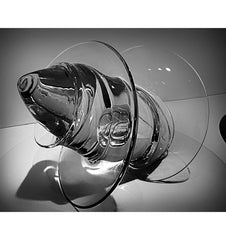
The Toso family has a 700-year uninterrupted tradition of Murano glass blowing, creating glass vessels that became the jealously guarded treasures of Venetian aristocracy. The past 50 years of that history have belonged to Maestro Gianni Toso.
"I had a hard time with regular school. They tried to teach me things that were strange to me" he says. "What I knew were the things that I was familiar with, the color, the glowing, the shape of glass”.So, at 10, he started working in a glass factory without his parents' knowledge or permission, laboring up to 12 hours a day feeding wood to the factory's furnace. His salary was $1 a week.
His parents allowed him to continue working in the factory full time - provided that he attended school at night.
At 14, he was accepted into the Abate Vincenzo Zanetti, Maestro d'Arte fine arts academy for master glass blowers on the island of Murano, where he would learn for seven years. The philosophy behind the school was that artists should be well rounded. They should know geometric design, art history, painting, and through that knowledge learn how to create new glass forms. All the. while, he augmented his academic work with practical work in the factories, making anything from chandeliers, to goblets, to ashtrays.
For 14 years, he studied under the finest masters in 12 different factories, learning their secrets.
At 23, he left the factories and opened his own small studio, producing lampworked souvenirs.
Lampworking, he says, was inexpensive, but he had to teach it to himself because it was not taught in the factories.
In 1967, at the age of 24, he opened a studio in the Jewish Ghetto of Venice. His workbench was a washboard held up by two sawhorses, and he created a line of 12 animal figurines that he sold to souvenir shops in San Marco.
But in Venice, the world of art started to open up for him, as the city started to influence what he did with his craft. "There was art in every rock in Venice," said Toso. He started to push the limits of his craft, and in 1969 made a chess set, "Jews vs. Catholics," that depicted the leaders of two opposing theologies, Catholic Franciscan Priests battling Hasidic Jews.
It won him first prize in an exhibit of Murano's master glassblowers, and shortly after, he was commissioned by Salvador Dali to make a series of 12 of the painter's surrealistic flowers in glass.
The medium truly became an art for Toso, however, in 1972, when he was invited to participate in the International Glass Symposium at the Museum Bellerive in Zurich, where Harvey Littleton intended to explore glass as an art form. Toso was the only Venetian invited.
It was not a simple decision for Toso to attend. Venetian glass blowing techniques were zealously protected, and he had to consult with his family about what he could and could not share. In the old Venetian Republic, if a glass blower left Murano and went to another country, he was killed, and the government seized all of his family's property and possessions.
For two weeks, Toso lived and worked with glass artists from all over the world. "There, from all of the good energy and enthusiasm, particularly from the American artists, for the first time in my life I shared ideas with strangers, and with people who like myself did not see glass only as artisans who make craft production," said Toso. "It was a fantastic cultural happening."
Toso had known that he was an artist, but he had always thought that he would express his artistic nature through painting. Glass was a unique medium, but it was a medium for craft, through which he could make a living. The symposium changed his attitude.
While craft was a matter of repetition, fine art, says Toso, has a way of making people think, and a way of opening space, and of opening doors.
He became an important figure in the Glass Studio Movement to spread glass blowing as an art form.
Marvin Lipofsky first came into contact with Toso in Zurich, and subsequently spent time working with him on collaborative projects in Venice. In 1979, Lipofsky, then the chairman of the glass department at the California College of Arts and Crafts, organized a glass-blowing tour of art departments in American universities to teach Italian techniques, with Toso as the headliner. Toso became the first Venetian to teach Italian techniques to Americans. He also fell in love with the freedom of American culture. Disenchanted by political strife in Italy, he sold his studio in the Venetian ghetto in 1981 and moved to New Jersey with his wife, Karyn.
"In America, I saw the future and continuity of my family's tradition, and the future of the Glass Studio Movement."
Toso is widely recognized as one of the world's finest glass blowers. He has created works that are displayed in galleries and private collections in the United States, Australia, Belgium, Germany, Israel, and Japan, and he has guest-lectured in art schools and galleries throughout the world.
He is known as an innovator in lampworking. While many contemporary glass artists have set up studios that are essentially factories that create fine art, Toso works unassisted in a studio surrounded by a vineyard that he planted on the property of his Baltimore home, where he continues to explore his medium as an art form.






george vick
Jun 10, 2022 at 16:44Have incorporated Gianni Toso’s ‘Chess Set’ 1985 into my docent tour at Norfolk’s Chrysler Museum. Thank you, George Vick